Sauna and hammam: how are they different?

Every culture has its own recipes for cleansing and maintaining beauty. So, in the Scandinavian countries it is a Finnish sauna, and in Turkey it is a hammam. Despite the fact that both those and other procedures are carried out under the influence of steam, there is still some difference in the temperature background, the level of humidity and the principles of construction between them.
Peculiarities
Sauna
Sauna is known as a Finnish bath, it is present in almost every Scandinavian home, public institution and hotel. There are saunas in many sports facilities, clinics and factories. They are distinguished by hot, but dry steam. The heating temperature in the steam room can reach 140 degrees, while the humidity level does not exceed 15%. This combination makes the air in the room light. On average, the temperature is maintained at around 60-70 degrees, which makes it possible to install a sauna in any cottage and even in an apartment.



The principle of the functioning of the sauna is quite simple - the fire in the firebox heats up the stones, they give off the received heat to the inside of the steam room, thus heating the air to the required temperature. The saunas are equipped with chimneys that allow the steam to escape safely from the steam room.
When the required heating level is reached, visitors to the sauna sit on benches and from time to time pour hot water into the firebox to get a new portion of steam. Many add essential oils to it, which improve the functioning of the human respiratory system. The heated air causes intense sweat separation - this principle forms the basis of the entire bath procedure.
Most often, after the steam room, visitors take a cold shower or plunge into ice water (pool or even an ice hole) - this way the body is cooled to normal temperature.
Infrared saunas have recently become popular. Heating of air masses in them occurs due to infrared emitters mounted in the walls and ceiling of the room.
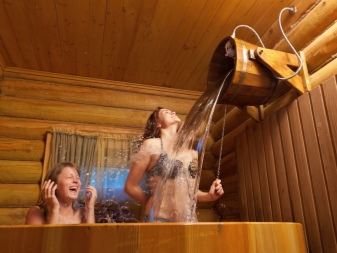
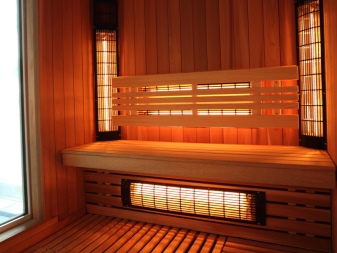
Hammam
The principle of operation of the Turkish hammam differs in many respects from the traditional sauna, but this did not prevent it from gaining a huge number of fans. The popularity of this bath is due to its inherent oriental flavor and specific effect on the vital organs and systems of a person.
The temperature in the Turkish hammam varies from 32 to 52 degrees, and the humidity is kept at around 90-95%. The ceiling in such a bath remains cool - this allows the steam to settle and condense on its surface.
The hammam in the classical technique includes several rooms, which are conventionally divided into technical and directly bath rooms. In the auxiliary block, the equipment is located and hot steam is generated, from there it is fed through the equipped channels to the bath rooms. In the past, steam was obtained by keeping water boiling in a large boiler; today, a steam generator is installed for this.
The steam causes uniform heating of the walls, as well as the floor and beds. Thanks to this effect, there is a uniform heating of bones, muscles and joints.


The sauna part includes three rooms, each of which has its own purpose. There is a comfortable dressing room near the entrance, the temperature in it is maintained within the range of 32-35 degrees. The design provides for the installation of a shower so that users can wash off sweat and dirt from themselves.
Next comes the steam room itself, here the heating level is higher - 42-55 degrees.In spacious hammams, rooms are additionally provided, where, if desired, the temperature can be increased to 65-85 degrees, but such conditions are the exception rather than the rule.
Highly humidified air is pumped into the steam room, so the steam is felt physically. In addition, the air can be additionally aromatized - this allows the vacationer to fully relax.
The third area in the hammam is a relaxation area, where you can fully relax and unwind after the procedures, drink a cup of herbal tea and chat with family and friends.
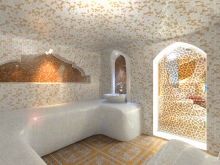
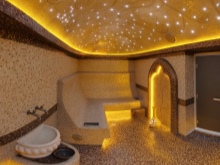

Comparative characteristics
The main difference between a Finnish sauna and a hammam is that they offer different levels of heat and humidity. In saunas, air masses are warmed up to 100 degrees or more with a humidity of no more than 15%. In the hammam, the microclimate is completely different - the temperature does not exceed 45 degrees, and the humidity reaches 95%.
Users note that despite the warm air, it is easy to be in the sauna, while the high humidity of the hammam is too heavy for people with problems of the cardiovascular and endocrine systems.
The Finnish bathhouse is lined with wood material from the inside, while the hamam is a brick building, which is trimmed with stone inside.
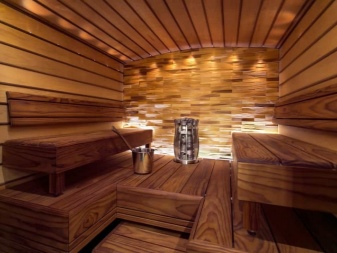

In order to achieve the desired level of heating, a special stove is installed in the sauna directly in the steam room. A metal casing is formed around it, which is located at some distance from it - the hot air mass penetrates from the floor into the formed gap, passes near the hot oven, rises up and diverges throughout the steam room. Thanks to this structure, heating the room takes very little time.
The principle of heat spreading in the hammam is slightly different. Special equipment is installed here - a generator, which is responsible for generating steam. It is served in the steam room through a branched system of pipes, which heat the hamam.
In fact, such a generator is a large vat where water is kept boiling. The steam temperature reaches 100 degrees, the steam itself is saturated with moisture and spreads along the bottom.

What is the best choice?
When choosing between a soft hammam and a hot sauna, one should proceed solely from personal preferences, well-being and other subjective factors. Some people, especially the elderly, do not tolerate hot air quite well, therefore, according to microclimatic characteristics, they prefer a more gentle hammam. Many users, on the other hand, like the heat, so they prefer a Finnish sauna.
The sauna is suitable for people without heart disease. The fact is that it is difficult to breathe hot air even though it contains little water and a lot of oxygen. When the heating of the air masses in the room exceeds the mark of 36.6 degrees, sweat begins to be intensively produced in the body of any person. In conditions of low humidity, it evaporates rather quickly from the surface of the skin.


A Finnish bath will be the best solution for:
- users who are recommended to stay in a humid environment;
- those who prefer a mild thermal effect on the body;
- relieving nervous tension, stress and depressive conditions;
- removal of toxins and toxins from tissues;
- reducing the manifestations of fatigue;
- training hormonal levels and the work of the autonomic system;
- increasing immunity;
- treatment of bronchopulmonary diseases, pathologies of the urinary organs and the musculoskeletal system.

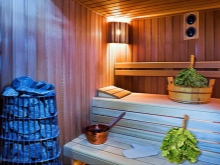

In the hammam, the humidity is increased, and it tends to condense on the skin, which is why perspiration in these baths is minimal, and a wet body is nothing more than a consequence of condensation. The epidermis and hair do not dry out during the procedure, so this effect is considered more favorable for allergy sufferers and people with skin diseases.In such a sauna, the pores open much faster than in a Finnish bath, so hammams are more effective from a cosmetological point of view.
Hammam is indispensable for:
- fans of solarium and spa treatments;
- restoration of the work of the heart and blood vessels;
- uniform heating of joints, ligaments and muscles;
- getting rid of stressful conditions;
- therapy of diseases of the nasopharynx and ARVI;
- accelerating metabolism;
- general rejuvenation of the body.


The topic of weight loss deserves a separate consideration. To begin with, we note that getting rid of the hated kilograms with the help of only one bath, be it a hammam or a regular sauna, will not work. Of course, both types of procedures can help to lose excess body weight, but in the very near future it will return - immediately after the volume of fluid in the body is restored. However, if your task is to get a well-groomed and beautiful look, then it is better to give preference to the hammam. It is especially effective against skin diseases, flaking and orange peel.
Due to the accelerated metabolism, the subcutaneous fat layer is split much faster, due to the expansion of the pores, harmful toxins, as well as toxins and excess fluid, are completely removed from the tissues.

There is no unequivocal opinion about what is preferable after an intense workout - a hammam or a sauna. So, staying in a Finnish bath dispels lactic acid accumulated in muscle tissue, effectively relieves painful sensations. Usually, trainers advise to do a small stretch after a hot sauna - it allows you to train your muscles as much as possible.
The Turkish hammam after sports helps to relax, as well as restore the spent energy, normalize breathing, improve the work of the sebaceous glands and cleanse the skin. It can be visited both before and after sports.
However, no matter how significant the differences between a sauna and a hammam are, only one thing matters - both steam rooms help to improve health and contribute to the prevention of many pathological conditions.

For the fundamental differences between a sauna and a hammam, see below.








The comment was sent successfully.